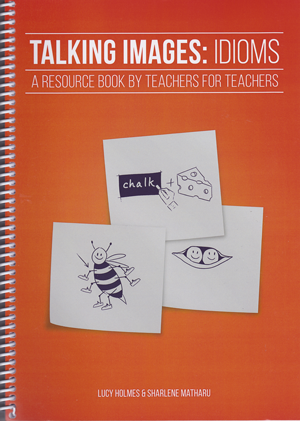Talking Images: Idioms
Talking Images: Idioms
by Lucy Holmes and Sharlene Matharu Lucy Holmes and Sharlene Matharu 2017 978-15272-1-555-9

This self-published photocopiable resource book is a delightful way of teaching idioms in a creative, meaningful and fun way.
The material is divided into 12 units, each working on a different theme, such as feelings, health and fitness, travel, relationships and money. The units follow the same pattern, beginning with Teacher’s Notes, which provide teacher-friendly instructions on how the units should be taught, as well as the answers to the exercises and the key vocabulary the students need to know for that particular unit. The next two pages focus on various activities to practise the 12 idioms featured in each unit, and these include speaking activities where the students have the opportunity to use the newly-acquired language in a communicative way. The last section has picture cards illustrating the idioms.
The units are based on the PPP (Presentation–Practice–Production) approach, and they all start with a warm-up, followed by practice activities with a special focus on accuracy – which is vital, given that idioms are extremely fixed expressions. The follow-up activities range from free conversations to open questions or discussions, so boredom is never part of this book. There are also homework and revision tasks to help the students consolidate what they have learnt. At the back of the book is a table with all the idioms, and a very useful index.
I have tried out the units extensively with a number of students at different levels, and they have proved to be engaging and motivating. This book has also helped me supplement my main coursebook and add variety to my lessons. I have observed that the game-like aspect, where the students have to look at a picture card to work out what idiom it represents, was a productive speaking activity in itself and generated a lot of discussion. I have also noticed that even after a few weeks, my students were still able to remember the expressions.
My only reservation is that most of the idioms are not in context, so the teacher needs to provide a context or explain when an expression is used. By simply looking at the picture card and the idiom ‘bark up the wrong tree’, for example, a student would never be able to understand its real meaning, let alone complete the table with the definition. If the idioms were presented in context, the students would be able to work more independently and the lessons would be more student-centred.
Talking Images: Idioms works with idioms like no other book I have encountered, and it is ideal for any level, but especially B1 upwards. It is very well thought-out, and I fully agree when the authors say it is ‘a resource book by teachers for teachers’. Not only did my students enjoy every single lesson in which we used it, but I did too, so I thoroughly recommend it.
William Chaves Gomes
London, UK
Comments
Write a Comment
Comment Submitted